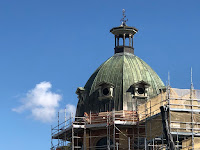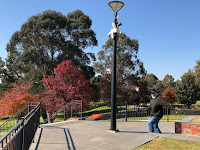 |
| Boer War and Carillon Memorials |
The first stop was the narrow park which lies between Church and Russell Streets, with George St at it's north and William St at the south and called Town Square. Another way of describing it would be to say it lies between All Saints Anglican Cathedral and imposing Old Court House. At the southern end of the park lies the Boer War Memorial, opened by Lord Kitchener himself in 1910. Local legend says that Kitchener came to town to do the deed but refused to until the name of Lt Peter Hancock was removed. Hancock was executed beside Harry "Breaker" Morrant during the Boer War for following what they alleged at trial were Kitchener's orders to shoot prisoners.
The dominant feature of this particular park is the 30 metre high War Memorial Carillon which lies at the geometric centre of Town Square. Contsructed in 1933 as a tribute to the soldiers who died in the middle east and Europe, it now stands as a memorial for that war and all which have followed. The sounding of the carillon is on the quarter hour and on the hour, its 35 bells sing a harmony of the number of the hour. The smallest bell weighs 8kgs and the largest 1,575kg. Each are inscribed with the crest of Bathurst and the largest three with the words of dedication from the people of Bathurst to those who have served. In the pit of the carillion, on the ground floor, a gas fed eternal flame used to burn, but in 2019 it was replaced with a bronze statue representing the eternal flame. The sculptor, Terrance Plowright, also fashioned the image of Steve Waugh, with cap in hand, which can be found at the Sydney Cricket Ground.
 |
| The dome of the old Courthouse Building |
To the west of Town Square is the magnificent Old Court House building, with its high dome of copper sheeting, sandstone entrance portico and two distinct wings which face Russell St. Of course, most of that is covered by scaffolding and building screens at the moment as restoration work of the original building, constructed in 1880 is undertaken. It will be again, when work is finished, the most imposing building in Bathurst.
Its a lovely park, with one exception. The Grand Fountain, referred to often as the Crago Fountain was opened in 1891. It is, without doubt, the ugliest fountain I have ever seen: so bad in fact, that I wouldn't photograph it! Goggle-eyed fish at its base and one heron mounted further up with clear spaces for others which were either never installed of knocked off. Its a dreadful eyesore.
After our wanderings, we joined an old cricket team mate from Armidale days, Brian Mair, for lunch. Brian has not long retired after a long career teaching and raising his family in Bathurst. We had a lovely time catching up and going back just a bit to talk old times.
 |
| Click here for today's photos |
Our last stop for the day was the Ballarat Regional Art Gallery (BRAG) for a look at two excellent exhibitions.
Loving the road.












